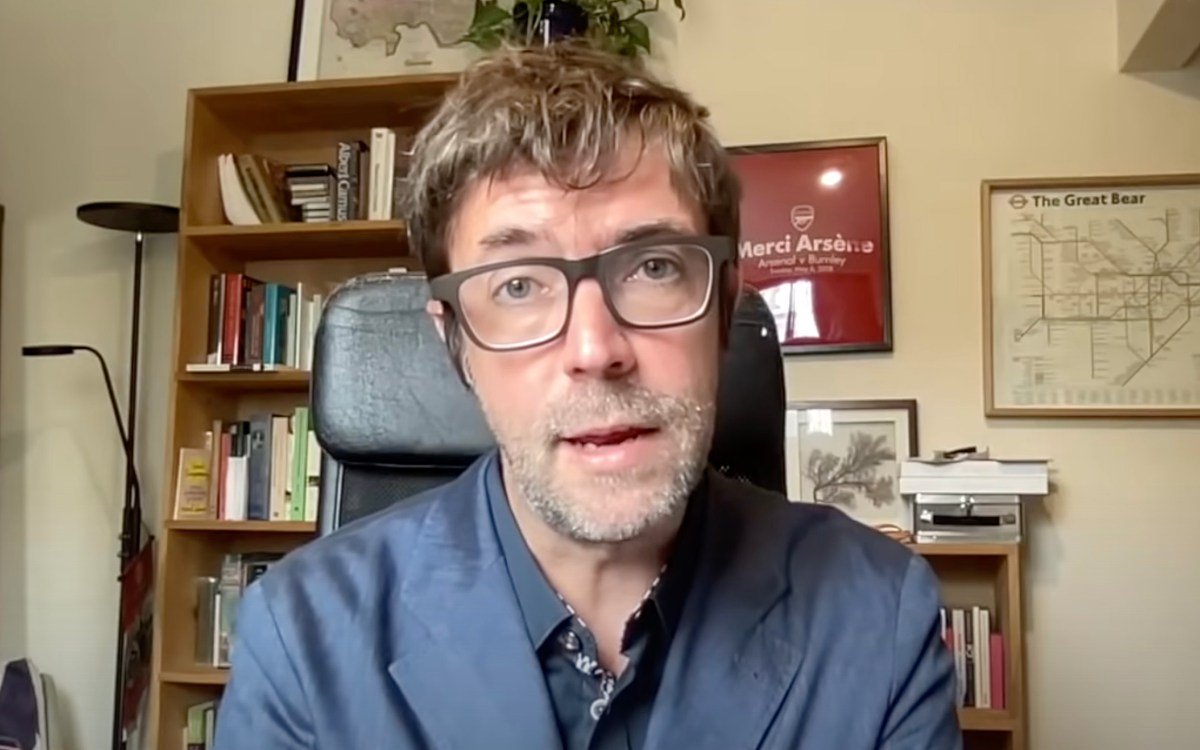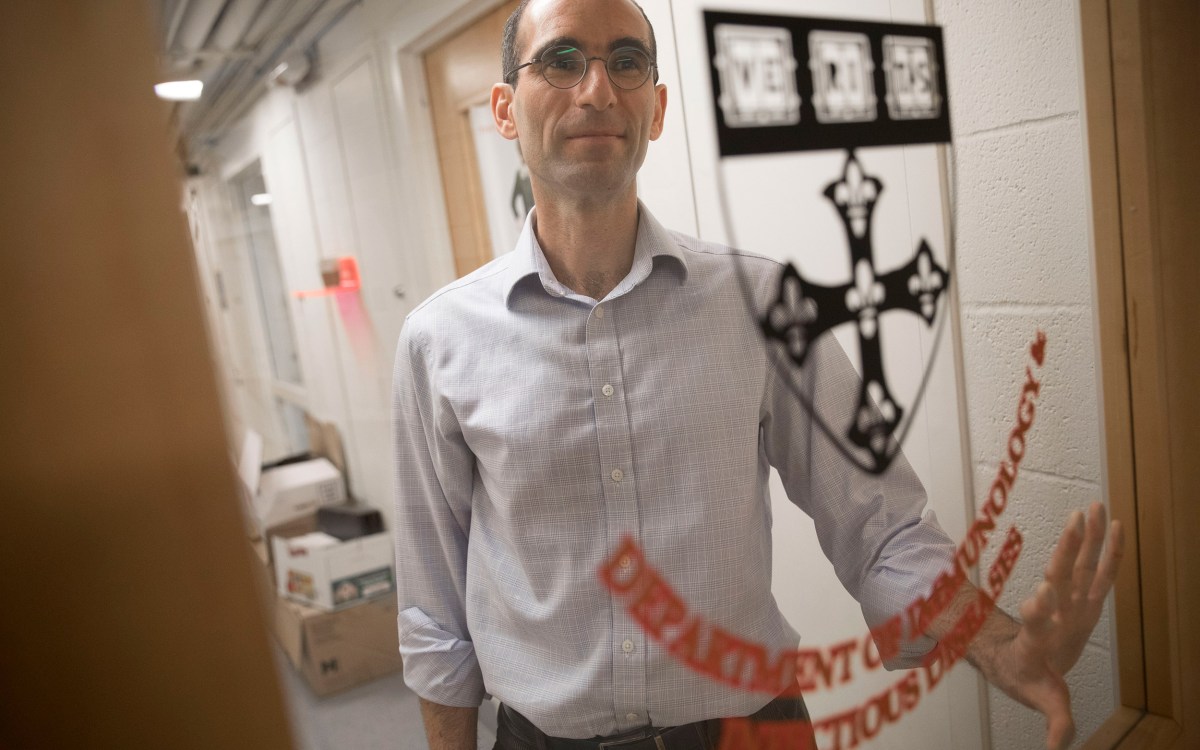Omicron ‘astonishing to behold,’ says Hanage
Harvard epidemiologist shares early impression of variant as first U.S. case is identified in California

Harvard Chan School epidemiologist William Hanage says it may be months before Omicron’s transmissibility among vaccinated individuals is known.
Photo by Kent Dayton
Pandemic scientists have spent the last few days racing to learn more about the coronavirus variant Omicron, which spread rapidly in South Africa last month and now has been detected in several other nations. William Hanage, an associate professor of epidemiology at the Harvard T.H. Chan School of Public Health and co-director of the School’s Center for Communicable Disease Dynamics, spoke to the Gazette about Omicron a few hours before the first U.S. case was reported in California. The interview has been edited for clarity and length.
Q&A
William Hanage
GAZETTE: There seem to be a lot of unanswered questions about the variant. What can we say for sure about what is happening in South Africa?
HANAGE: Hospitalizations in South Africa are tracking up in a way very similar to previous waves, but lagging behind what looks like a truly extraordinary increase in Omicron cases.
GAZETTE: So cases are rising faster than hospitalizations?
HANAGE: Yes. The more complicated thing is that we don’t yet know what it’s going to do in very highly vaccinated populations. We know of a case from Israel in which a person who had received three shots transmitted to another person who had received three shots. I don’t want to overstate that single data point, but the fact that we have noted that happening already is important in terms of the ability of three shots to control transmission. Three shots can still be highly protective, though. I would fall off my chair if it turned out that the vaccines’ efficacy against serious illness was seriously affected.
GAZETTE: When the vaccines came out, manufacturers emphasized protection against severe disease as the most important effect. At this point, it seems like that is still going to be the case?
HANAGE: Data is still coming in, but that’s my expectation based on the amount of antibodies which are generated by the vaccines. One thing that was being underreported before this was the fact that if a lot of people got boosters, we had the prospect of the virus struggling to infect a person who had received three shots. And, at least in the short term, people with three shots would be substantially protected against all infection. It’s early days, but it looks like that’s not going to be the case with Omicron. What remains to be seen is how serious the infections are. That’s the crucial thing.
About all we can exclude are the extremes. We know that it’s not very mild because hospitalizations are ticking up in South Africa. We know that it’s not incredibly serious, because hospitalizations are ticking up but not incredibly fast. So, all we can exclude is the extremes, and there’s a lot of room between those extremes for the virus to spring a nasty surprise upon us.
GAZETTE: Was the initial response a media overreaction or, given the pace of the spread in South Africa and its almost immediate designation as a variant of concern by WHO, was it appropriate and a sign the warning systems are working as designed?
HANAGE: The warning systems are certainly working as they should. That’s absolutely the case. But you’re right that there was a frenzy unlike any that I can remember. I think it’s understandable, given the rapidly changing situation. But I would urge people to realize that even in a rapidly changing situation, you shouldn’t be relying on rumor and you shouldn’t be relying on hearsay. Remember that the thing that is most likely to be wrong is the thing that you heard most recently, because we’ve not had the chance to verify it yet.
More like this
So recognize that this has capacity to be quite serious, but that doesn’t mean the sky is falling. We are still in the process of learning a lot more — and we are not going to know it overnight. That’s an important thing. We’re not going to be able to securely nail down things like transmissibility among vaccinated individuals, or the risks of severe illness to vaccinated individuals, for weeks or even months. Even then, we’re still not going to be clear on things like age and the amount of time since people have had their shots, and exactly which shots they got, and so on.
GAZETTE: What are the implications of this for the end of the pandemic? It seemed like we were heading toward a situation in the U.S. with widespread resistance from vaccination or infection, where the virus is still here but illness is largely less severe. Does this push that back?
HANAGE: Yes. But I think that it’s reasonable to say that whatever is going to happen with Omicron could happen really quickly. The other thing I would point out is that anybody who has talked about the “end of the pandemic” has been doing people a disservice. Because you don’t get “ends,” what you get is a point where, gradually, people are able to chill, and they chill at different rates depending on their own attitudes about risk. Eventually, we get to a point where the pandemic is in the rearview mirror, but that point is going to be different for everybody. What this definitely means is that those of us who work in public health and those of us who work in infectious disease have got something new, serious, and very concerning on our plate to deal with. Looking at the sequence of Omicron is one of the most extraordinary moments I’ve experienced over a couple of years, which themselves have been extraordinary,
GAZETTE: Is that because of the mutations?
HANAGE: Yes, there are just so many of them, and where they are. Privately, I had frequently expressed concern over something like this happening, albeit in speculation. But it’s still fairly astonishing to behold.
GAZETTE: I had always thought that Delta was the variant that everybody was afraid would arise, and here we have Omicron.
HANAGE: The wild thing about Delta is that it doesn’t have that many mutations. It wasn’t the triple mutant. It wasn’t the one that everybody was going crazy with worry over. It was the quiet one — and you know the quiet ones are the most dangerous. Delta also has that combination of being highly transmissible and a bit more dangerous. That was why it was particularly angst-inducing. But Omicron is a different beast and we’re still learning about it. But all the early indications are that it is serious.









